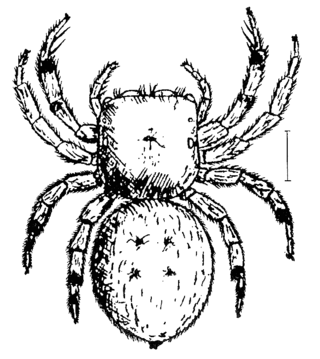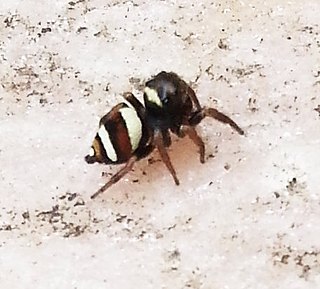
Chinattus is a genus of jumping spiders that was first described by D. V. Logunov in 1999. The name is a combination of "China" and -attus, a common suffix for salticid genera.

Epeus is a genus of the spider family Salticidae. They are often found on broad-leaved plants or shrubs of rain forest, or in gardens of Southeast Asia.

Irura is a genus of the spider family Salticidae.

Langona is a genus of spiders in the family Salticidae. Langona species are similar to those of the genus Aelurillus. In 2015, it was listed in the subtribe Aelurillina. The subtribe is allocated to the tribe Aelurillini in the clade Saltafresia. In 2017, it was grouped with nine other genera of jumping spiders under the name Aelurillines.
Laufeia is a spider genus of the jumping spider family, Salticidae, with a mainly Asian distribution, where they are found on tree trunks and branches or among leaf litter.

Neon is a spider genus of the jumping spider family, Salticidae. Its described species occur mostly in Eurasia, with some species found in North and South America. One species, N. convolutus, is also found in Algeria. Two species are known from Australia, N. australis and N. taylori. N. australis has palp morphology and fringing on its first pair of legs very similar to that seen in N. nojimai Ikeda 1995, from Japan. N. taylori is most similar in morphology to N. sumatranus from Indonesia and N. kovblyuki from the Crimea and elsewhere. The genus is common and widespread in litter throughout Australia, from the highlands of Tasmania through the hot, dry inland to the wet tropics and includes many undescribed species.

Onomastus is a genus of Asian jumping spiders that was first described by Eugène Louis Simon in 1900. It is the only genus in the subfamily Onomastinae.

Pancorius is a genus of Asian jumping spiders that was first described by Eugène Louis Simon in 1902. They are similar to Hyllus.

Ptocasius is a genus of Asian jumping spiders that was first described by Eugène Louis Simon in 1885.
Spartaeus is a genus of Asian jumping spiders that was first described by Tamerlan Thorell in 1891. These spiders build large sheet webs on tree trunks to capture prey, mostly moths. When walking, they wave their palps and legs in an unusual way.

Stenaelurillus is a genus of jumping spiders that was first described by Eugène Louis Simon in 1886. Most species live in Africa, with some species found in Asia, including China. All species have two white longitudinal stripes on the carapace, and both sexes show strong bristles around the eyes. The name is a combination of the Greek sten- "narrow" and the salticid genus Aelurillus.

Synagelides is a genus of Asian jumping spiders that was first described by W. Bösenberg & Embrik Strand in 1906. This genus and Agorius are separated as a genus group, sometimes called subfamily Agoriinae, but more recently downranked to tribe Agoriini of the Salticoida clade in subfamily Salticinae.

Belisana is a genus of cellar spiders that was first described by Tamerlan Thorell in 1898.

Wanda Wesołowska is a Polish zoologist known for her work with jumping spiders. She has described more species of jumping spider than any contemporary writer, and is second only to Eugène Simon in the history of arachnology. Originally a student of ornithology, she developed an interest in jumping spiders while still a student at the Siedlce University of Natural Sciences and Humanities in the 1970s.
Marusyllus is a genus of spiders in the family Salticidae, found in Russia, Central Asia, the Indian subcontinent and China.

Phintella parva is a species of jumping spider in the genus Phintella that lives in China, Japan, Korea and Russia. The species was first described by Wanda Wesołowska in 1981 based on a holotype from North Korea. However, retrospectively; it was recognised that other examples of the spider had been previously collected and, at one time, a description published without a species name. The spider is small, between 3.5 and 4 mm long, and yellow. The female is slightly larger than the male. The abdomen has a striped pattern and the carapace has circular markings, but the most distinguishing difference between this species and other members of the genus are its copulatory organs, particularly the short curved embolus on the male and long straight insemination ducts in the female.

Phintella pygmaea is an endemic species of jumping spider in the genus Phintella that lives in China. It was first described in 1981 by Wanda Wesołowska from a holotype discovered in Guangdong. Only the female has been identified. The spider is small, with a brown cephalothorax and yellow abdomen. It has distinctive half-crescent markings on the cephalothorax and a ridge marked by two depressions on the small epigyne.
Euochin is a genus of east Asian jumping spiders first described by Jerzy Prószyński in 2018. The genus was split off from Euophrys. Prószyński placed the genus in his informal group "euophrydeae" within the "euophryines", the latter being equivalent to the tribe Euophryini, which is part of the subfamily Salticinae.
Rhenefictus wandae is a species of jumping spider in the genus Rhenefictus that lives in China and Vietnam. First described in 2021 by Cheng Wang and Shuqiang Li, it was initially allocated to the genus Rhene. In 2022, the species was acknowledged as the same as Rhenefictus tropicus and the two were synonymised under the current name. It is the type species of the genus Rhenefictus. Only the male has been described. The spider is small, with a dark red or dark brown carapace between 2.35 and 2.4 mm long and a brown abdomen between 2.4 and 2.98 mm long. The base of the abdomen is grey-yellow. The spider has a distinctive embolus on its palpal bulb that is coiled and whip-like, terminating in a pointed tip.












